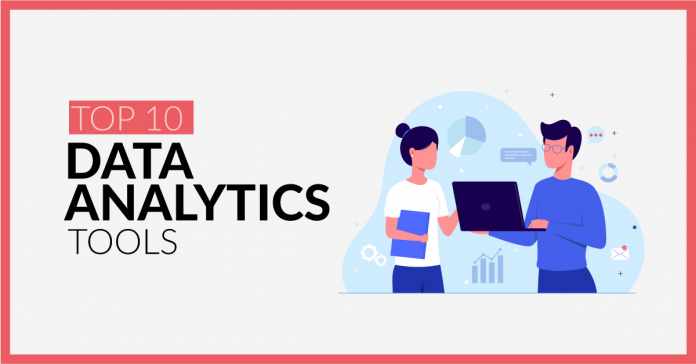Almost everyone is now aware of the massive amount of data we generate every day. Most of that data is in raw format. Now, the trick here is transforming that raw data into usable information which can assist in decision making. When this raw data is analyzed effectively, hidden trends and correlations are found in the data, which if communicated to the stakeholders can help in drawing meaningful insights. Companies accomplish this complex task by hiring skilled data analysts. Read on to find the ten top best tools for data analytics.
The job of a data analyst has become one of the most sought-after roles these days. To stay ahead in the competition, companies are investing more in digital initiatives and seeking professionals who are skilled in data analytics. As such, professionals are adding data analytics certification to their skillset to become eligible for the available opportunities in this evolving field. To make the job of data analysis easier, various powerful tools are being introduced in the market and are unleashing the potential of Big Data.
With big players like Amazon, Google, Salesforce, and IBM entering the big data analytics market, selecting the best tools for data analytics can be a daunting task. The choice becomes even tough when you are seeking an open-source data analytics tool. With this article, we would help you in making the right choice by listing some of the best data analytics tools whose services can be used free of cost.
Table of Contents
Top 10 Open tools for data analytics
Here are your top choices for free tools for data analytics.
KNIME
The KNIME Analytics platform helps organizations take their performance to the next level by providing intuitive access to advanced data science. Data scientists use it to discover hidden trends in data, mine fresh data, and predict new futures. The platform makes understanding data and designing data science workflows and reusable components accessible to everyone. Companies like Siemens, Continental, Daimler, and Seagate are some of its popular clients.
Orange
It is a machine learning and data visualization toolkit that lets you build data analysis workflows visually. With Orange, one can perform a simple data analysis with clever data visualization. Moreover, they can explore statistical distributions, decision trees, heatmaps, box plots, scatter plots, hierarchical clustering, and so on. It also supports hands-on training and visual illustrations of concepts from data science.
Tableau Public
Tableau is a leading data visualization tool and Tableau Public is its open-source platform. Without any coding knowledge, one can create fascinating interactive visualizations and embed them on a personal website or blog. Professionals use it to create charts, graphs, live dashboards, and stunning maps. You can connect to data in various formats like Excel, Google Sheets, or CSV.
Apache Spark
As described on its official website, Apache Spark is a unified analytics engine for large-scale data processing. It offers over 80 high-level operators to build parallel applications using any language like Java, Scala, Python, or R. Data analysts prefer it as it facilitates in-memory data processing (to achieve faster outcomes), distributed task transmission, scheduling, and I/O functionality.
Plotly
This tool makes it easier for data analysts to build, deploy, and share interactive web applications, charts, and visualizations in any programming language. It can deliver applications and dashboards that run advanced analytics like machine learning, NLP, forecasting, computer vision, and so on. There are around 4 million monthly downloads of Plotly open-source graphing libraries.
DataMelt
You can try DataMelt for the purpose of statistics, numeric computation, symbolic calculations, data analysis, and data visualization. It is a computational platform that can be used with many programming languages Java, Groovy, Python, and JRuby. It can run on Windows, Linux, Mac, and Android and is also available on the Amazon EC2 cloud.
Data Studio by Google
This is a free tool that Google offers to turn your data into informative, easy to share, and fully customizable dashboards and reports. It supports pie charts, geo maps, paginated data tables, clickable images, and more. It allows data to be collected from various sources like Google Sheets, Google Analytics, MySQL, YouTube, and even social media platforms.
Trifacta
This tool offers the fastest way to prepare data and create data pipelines in the cloud. The users get visual and intelligent guidance to accelerate data preparation and get insights faster. It supports the machine learning and data science initiatives by removing the bottlenecks of feature engineering and data cleaning. PepsiCo, Etihad Airways, Bank of America, New York Life, and Electrolux are some of its top clients.
Weka
Popular for data mining tasks, Weka contains a number of built-in tools for standard machine learning tasks like clustering, regression, visualization to support model building. Without writing codes, one can use the tool to create machine learning pipelines, train classifiers, and run evaluations. Weka also supports deep learning and assists in tasks like image and text classification. Further, the tools for data analytics can be integrated with popular data science tools like Python, R, and Apache Spark.
Talend Open Studio
Data integration is the initial step to gain insights from the data and Talend is the leader when it comes to top Data Integration Tools (2020 Gartner Magic Quadrant). Open Studio is a free version of Talend that offers services like – starting ETL projects and integrating data; simplifying ETL for large and diverse datasets; discover, blend, and clean data; speed up orchestration of applications and APIs; and quickly load data from any cloud source into the cloud data warehouse.
To sum up, all these tools are some of the best open-source data analytics platforms and you can choose one that best fits your project requirements.











![How to Unlock Bootloader without PC On Android [2022]](https://cracktech.net/wp-content/uploads/2019/02/unlock-boot.png)